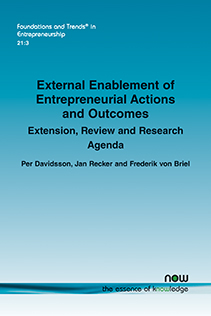External Enablement of Entrepreneurial Actions and Outcomes: Extension, Review and Research Agenda
By Per Davidsson, Queensland University of Technology, Australia and Jönköping International Business School, Sweden, per.davidsson@qut.edu.au | Jan Recker, University of Hamburg, Germany and Queensland University of Technology, Australia, jan.christof.recker@uni-hamburg.de | Frederik von Briel, University of Queensland, Australia, f.vonbriel@uq.edu.au
Abstract
The term ‘external enabler’ (EE) is a collective label for non-trivial changes to emerging and established organizations’ (macro) environment, such as new technologies, regulatory changes, demographic and sociocultural trends, and changes to the natural environment. Two fundamental assumptions of EE scholarship are that all such changes benefit some organizations, and that different types of change can offer similar benefits and potentials for strategic action. The external enabler framework (EEF) develops structure and vocabulary to guide cumulative knowledge development across different types of such environmental changes to inspire and guide research and practice regarding strategic and fortuitous leveraging of EEs in entrepreneurial pursuits. Citation statistics and a growing number of applications and extensions suggest that the EEF has been well received, and its application area has expanded well beyond its original domain of independent business startups to also include mission-oriented ventures, new initiatives and growth of established organizations of all sizes and ages, and the creation or rejuvenation of industries, ecosystems, and local economies. In this monograph, we update and elaborate on the EEF and review the scholarship that has evolved around it to take stock of past developments and guide and inspire future research and practice in this important domain.
External Enablement of Entrepreneurial Actions and Outcomes: Extension, Review and Research Agenda
External Enablement of Entrepreneurial Actions and Outcomes illustrates the broad relevance and applicability of the External Enablement phenomenon, concept, and framework. The monograph describes at length the definition and meaning of external enabler/enablement and the main elements of the External Enablement Framework (EEF): characteristics, mechanisms, and roles. The monograph also reviews the growing scholarship that is evolving around these conceptualizations and provides ideas for future applications in research and practice. Later sections outline possible future research directions. There are two appendices providing a summary review of the EE articles published to date and answers to frequently asked questions about the EEF.
